Page title is a very short overview of your web pages shown on other websites attracting new visitors to your website. Writing a good page title will optimize your pages for SEO and bring more visitors to your content.
Think of page title as an advert that is being shown on popular websites with millions of daily visitors like Google, Facebook, Twitter and other social networks, forums and blogs. Writing SEO friendly page title is a free advertisement for each page of your website.
Optimizing your titles is one of the free ways of increasing traffic to your website. This is also known as an effective way to increase CTR. Because your goal is to display your title and increase clicks by real users that will visit your website.
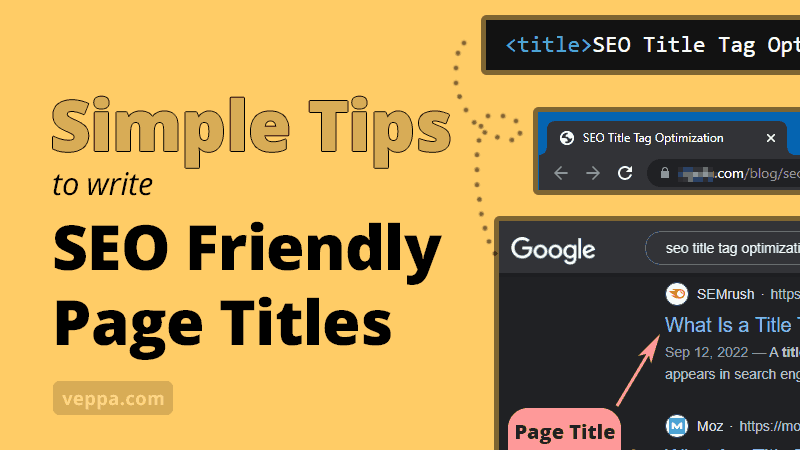
In this article you will learn best practices to optimize your page titles for better SEO. Additionally we will discuss how to offer alternative title that can be used by google algorithm for auto generating custom title tags for different search queries.
You will also learn how to add custom titles in WordPress and use an SEO friendly title checker tool.
Table of Contents
What is a page title and why is it important?
Page title is text that is displayed in the browser tab or window. It is short descriptive text explaining page purpose and content.
Page title is not visible inside the page itself. It is defined as HTML code of the page and shown as tab title. Here is the code that appears in HTML wrapped with <title> tags.

This tag is then displayed in the browser tab or window itself depending on the web browser user visits your website.

Besides appearing as a window title it has a more important role in SEO. Page title is used by search engines to show your content in search results and link to your website. It will be visible to people who search your website on Google, Bing etc.
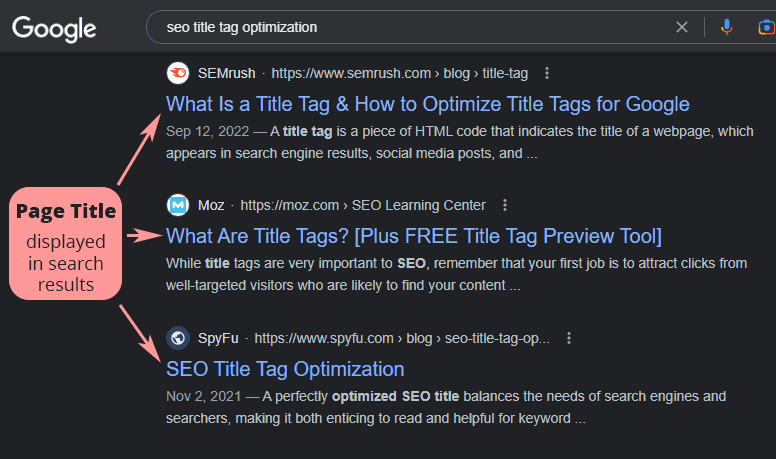
Appearing in Google is the most important part of page title SEO as it affects traffic volume and quality you get from search engines.
Here are 3 important SEO factors that page title plays role:
- Position in search engine results
- Number of keywords that show your page in SERPs.
- Click Through Rate (CTR)
The goal when optimizing page titles is to make our website appear in top positions for multiple related keywords and get more clicks from people searching for our content.
Apart from search engines, page titles also appear in social media and other websites where your content is shared.
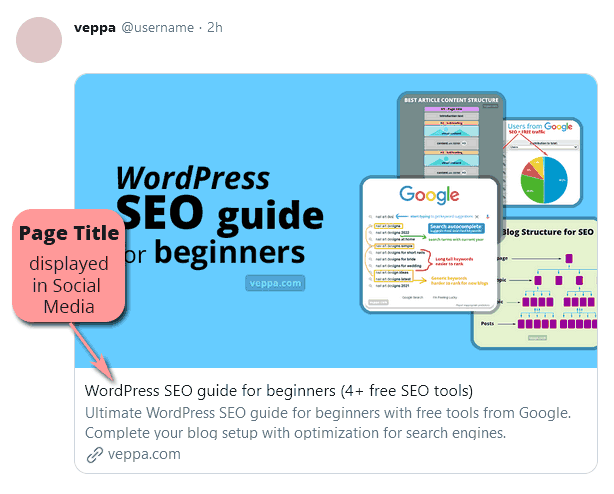
This is an example of how page titles will be shown in social media. Page title will help people understand your page content and decide whether they are interested in visiting your website.
Well optimized page titles will help to increase the number of visitors from social media sites like Facebook, Twitter, Linkedin, Reddit. Same title will be shown when your content is shared in any social media application or website.
You can control what is shown on other websites by tuning your page title. That is the main reason for writing SEO friendly page titles. Now lets see how to optimize page titles for your website.
Best practices to write good page title
We all want to have the best possible version of page title on every page on our website. Here are 8 simple tips to create well optimized SEO friendly page titles.
- Write specific title that describes each page
- Write for users
- Include relevant keywords
- Mention unique feature of your content
- Use long tail keywords
- Stay within 50-60 character limit
- Use brackets, parentheses and number where appropriate
- Don’t repeat or stuff keywords
Write specific title that describes each page
Each page on your website should be unique. So are the page titles that describe your content. When you have a duplicate title or very similar title then google will confuse which page is more relevant to the search query. As a result pages with duplicate or similar titles will not be shown in top positions on search engine results.
To avoid any confusion for search engines and users, always check your page titles and accent on unique features of your content. This can be a research, date or any feature that stands out from other pages on your website.
In the same way search Google for using keywords for your page and check results. Try to mention a unique aspect of your article that is different to your competitors. This way you will attract more visitors by promoting specific features of your article which will be visible directly in google results.
Write for users
Always pay attention to write page titles targeting users. Because:
- Users search google for finding related information.
- Users will decide to click on it for reading.
Users are both searching and clicking your titles. While search engine algorithms are responsible for indexing, ranking and showing your content. Ranking part is formed by multiple factors including user searches and clicks. So your main criteria when optimizing page titles should always be users.
Use search data it when finding keywords for your page title and when
How to optimize page title for users?
- Use search data which is formed by users over time. Keyword research can be performed by using autocomplete feature in Google search to find long tail keywords relevant to your page content.
- Create a page title that describes your page content and invites users to your website for learning more.
Include relevant keywords
Keywords are used to classify and rank your content in Google. When you use relevant keywords that are searched by many people in your page title you have a good chance to appear in google search results. Users are also more likely to click when they see the exact keyword that they searched for in your page title.
Try to use your target keyword at the beginning of your page title. Choose keywords that match user intent.
Mention unique feature of your content
When writing your page title, mention a unique feature of your article. This feature will work as a promotion point for your article. There is a different feature that is valuable for each search query.
Here are 5 features that are valued by searchers.
- Depth: Users like to learn every aspect of the searched topic. That is why long articles with more than a couple thousand words are valued. If your article is one of those in depth articles then mention it in your title. Here are common words that can show the depth of your article: “ultimate”, “step-by step”, “definitive”, “complete”, “case study” etc.
- Quantity/lists: People love when there are multiple steps or multiple solutions to their problem or point of interest. Mention quantity in your title if you have a list of items or number of steps.
- Freshness: Google values fresh and updated content because users want to find the greatest and latest solution. Mention in the page title current year “2023”, date of research “21 January” or date of update “October update”, start or end date “sale until 31 December” etc.
- Brand: Familiar brands will stand out for users when they see your page title in search results. If your brand is well known in your industry or your article is related to known brands then mention it in your title.
- Speed/easiness: People do not want to waste their own time. So they are more likely to click to learn quick efficient solutions to their problems. You can mention the time it takes to achieve the desired result in your page title or mention that it is a beginner friendly guide. Easy guides generally do not take much time. Use words like: “quick”, “easy”, “beginner friendly”, “in 5 minutes”, “today”, “now”. For e-commerce sites you can mention “fast delivery”, “free shipping” etc.
Use long tail keywords
Long tail keywords generally better describe your topic rather than 1-2 word keywords. It also makes your titles more precise and will lead to more focused traffic.
Long tail keywords are easy to rank for and over time your article can start ranking for main short tail keywords.
For example if our title is “Classifieds script”
Long tail page title would be “PHP classifieds script with mobile app”
Long tail version has more information in it and attracts only interested people to your web page.
Stay within 50-60 character limit
Google truncated title tags so it should fit to one line on desktop and up to 2 lines in mobile devices. Keep this in mind and try to not go beyond 60 character length. Also try to keep important parts of your title at the beginning so it is always visible to users.
If you want to use a longer title with more details then you can use it within your article as a title. This is usually a page or post title in WordPress and coded with <h1> tags in your page code. This title is visible on your web page. Users will see when they visit your website. Usually it is after clicking a link on search engines or social media.
Use brackets, parentheses and number where appropriate
Parenthesis (), brackets [], numbers 123, Title Case are visually distinguishing factors that can make your page title stand out from the crowd on a search engine results page. Use them when appropriate to accent on additional information mentioned in your title. For example “(Case Study)”, “9 Easy Steps”, “[updated]” etc.
Don’t repeat or stuff keywords
Do not try to stuff your page title with more keywords. It will not look natural and will look unprofessional. It will devalue your content and discourage people from visiting your website.
How to add a custom Page title in WordPress?
WordPress by default adds page title automatically using post or article title. Same title text will be used as Page Title <title> and post title <h1>. This is a standard way of using the same title for users and search engines.
However if you want to use different page titles then you can use SEO plugins for WordPress. All of them have custom title and description fields. I use Rank Math SEO in my blog because it has more useful features than others.
- Why do you may need a page title different from your article title?
- How to add page title with an SEO plugin?
- SEO friendly title checker tool
Why do you may need a page title different from your article title?
- Character limit. Optimal page title size is 50-60 characters. The article title can be longer than that. In the article title you may use a more descriptive title if you need to.
- Google can rewrite the default page title and replace it with article title for different user queries. We know that Google wants to show relevant information for each user query. Web pages generally rank for multiple keywords. Google algorithm may find your article title which is different from page title more suitable for some keywords and use it automatically. So your page may get more traffic with 2 different versions of title text.
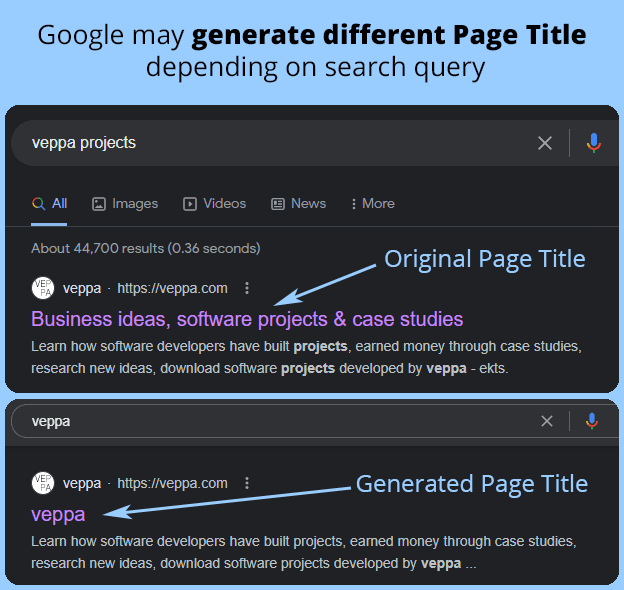
Here is an example how google generates custom page titles for different search query that points to the same page. In this case page title is generated from the site name. Google can use article title, any other title, visually distinguished text, site name or any other visible text from the same page.
To increase your chance of appearing with more relevant page titles use informative article titles slightly different from page title. Think of an article title as an alternative title for the same page.
How to add page title with an SEO plugin?
SEO plugins will show custom controls when editing Posts and Pages. You can write custom titles using these controls.
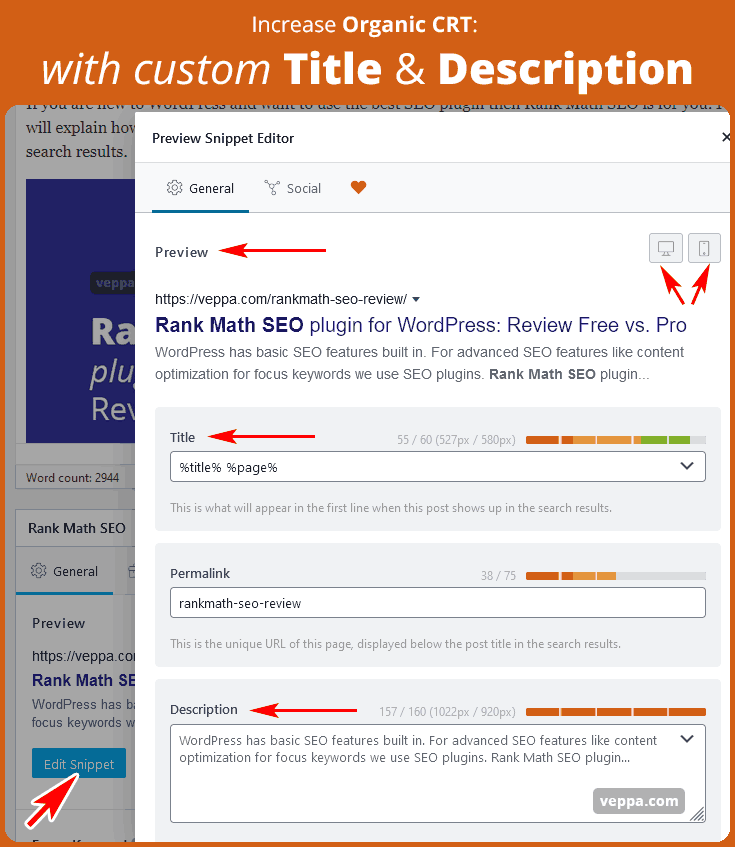
To add custom page title with RankMath SEO plugin:
- Navigate to edit posts or add the post page of your WordPress website.
- Click on the “Edit snippet” button on the post editing page. It is under the content textbox in Classic Editor and on the sidebar in Block Editor.
- After clicking it will show you a popup with current page title and meta description. You can write custom Page Title and description on that window. After writing your custom title you can also preview it on desktop and mobile devices with preview buttons.
- After editing, click on the “x” cross button on the right upper corner of the popup and save the post by clicking the regular “Update” button on WordPress.
WordPress SEO Plugin also shows the length of your title while you are typing so you can remain within the maximum suggested page title length.
SEO friendly title checker tool
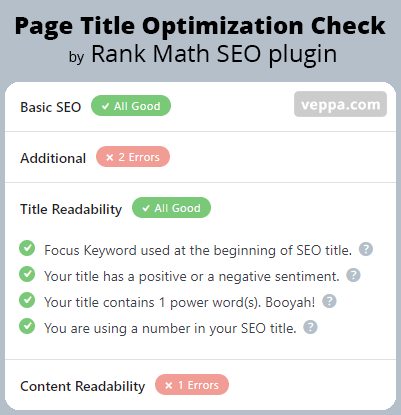
Apart from allowing you to write custom page titles, the Rank Math SEO plugin has an SEO friendly title checker tool. It will show if the page title contains your focus keyword, number, emotion and other optimizations that we mentioned in this article. Green checkmark for each optimization will make it easy to apply and verify if all possible optimizations to page title applied correctly.
Title checker tool works directly in your WordPress post editing page. It helps to save time by automatically checking page titles when you edit or publish new posts. You do not have to remember every available optimization option. Tool will show you missed optimization in red so you can fix them while writing your articles.
Learn more about additional page optimization in WordPress with meta tags, rich snippets and featured images to increase your organic CTR.
FAQ
Why does the page title need to be unique for each page on your website?
Page title represents content of the page. Having a unique title means you have unique content on each page. This will help search engines to index and show unique content from your website. Users also will benefit from unique title and land on page that is related to their search query.
Will Google always show my page title in SERPs?
Google tries to show relevant titles for each search query. In most cases it will use your original page title. For some queries Google may generate different page titles using relevant visible content from within your page. This can be article title, other titles, site name or any other text within your article.
What is the difference between page meta title and <H1> title for articles?
Page meta title is visible in search engine results on other websites when the page is shared. <h1> title also known as article title is visible on the page. In most cases text for both of them can be the same. Sometimes it is better to use a slightly different version in H1 as an alternative title and leave the decision of which one to use to the google algorithm.
Should I use a different page (meta) title and article title?
You can use different page meta titles and article titles when you want to be more precise in article description which cannot fit to the suggested page title length of 60 characters. Using different titles also can help to increase the number of search queries your page will be shown. Google will pick the best available title option depending on the user’s search query.
Conclusion
We have seen that page title is important information describing your page. Make it specific and use a suitable keyword that is searched by users on google. Add more distinguishing and convincing information about your page to your page title. Use number, year, parenthesis, Capital Case when appropriate.
Maximize page visibility in search engines by using slightly different <h1> title within your articles than your page title. Use WordPress SEO plugins to write custom page title and auto check for applied optimizations. Avoid duplicating page content and page title on other pages on your website.
Learn more optimization tips from my WordPress SEO guide.